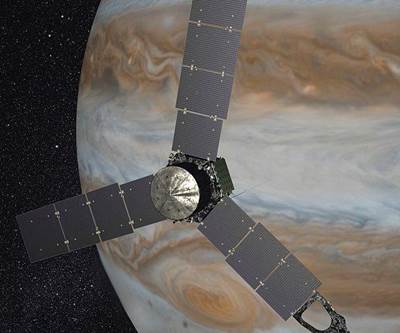Lockheed Martin: Importance of Closed-Loop Control in AM
Process repeatability will enable the satellite maker to apply additive manufacturing to the production of critical parts.
For Lockheed Martin Space Systems, one of the most valuable characteristics of Electron Beam Additive Manufacturing (described in this article) is its in-situ feedback loop. In this metal-deposition process from Sciaky, parameters such as the beam’s energy level are adjusted through closed-loop control to maintain consistent melt behavior throughout the build. That control makes EBAM distinct from other metal additive processes, the aerospace company says, and the repeatability provided by that control is one of the reasons why Space Systems expects to apply the process to the production of critical parts. Today, the company is working to validate EBAM as a means of manufacturing propellant tanks for satellites.
Lockheed Martin’s Slade Gardner, Ph.D., is a manufacturing researcher involved in this work. Once this process is validated, he says, the benefits of adopting it into satellite production will be considerable. Today, the propellant tanks begin as titanium 6-4 forgings. A forging in the shape of a mushroom cap is machined to produce a thin-walled hemispherical dome. Two hemispheres are joined together to produce a spherical tank. When the preform of the dome can be grown additively instead of being forged, Gardner says, the advantages will include all of the following:
- Lead time. Capacity on large forging presses is limited. Tank dome forgings frequently wait in queue for months, he says, contributing to the 12-month lead time that is typical to produce one of these tanks. By contrast, the first hemispherical preform made through EBAM (a small tank dome at 16 inches in diameter) was grown in just 3 hours. The work was not finished at that point, since the part still needed heat treatment, machining and joining to another dome. Still, the speed of that cycle made clear to Lockheed Martin from the outset that a dramatically shorter lead time could be attained.
- Processing cost. The forging for the titanium housing is not a hemisphere, even though the final component is. The difference means that most of the material of the forging has to be machined away to achieve the finished part. This imposes cost for the machining itself and for the material that is machined away. EBAM, by contrast, does produce a hemispherical part. The preform made this way is a rough hemisphere to be sure, but the machining required to complete the part is considerably less.
- Flexibility. Forging requires tooling, which limits design freedom. In order to avoid the time and cost of making a new die, engineers resist design improvements. “You always want to continue to use your existing tools,” Gardner says. But additive manufacturing is not beholden to hardware in this way. Implementing a design change in EBAM involves simply changing the program for the additive build.
Lockheed Martin sees a fourth advantage as well. Inherent to the closed-loop control is continuous measurement of the process. The data generated are extensive and valuable. “We know more about the creation of each additive part than we can reasonably know about parts created other ways,” Gardner says. And in the future, he says, the data could be marshaled to streamline the process to a degree that goes well beyond just replacing one metalworking operation with another. For example, given the in-situ process measurement, is a separate inspection step needed? Today it is. But perhaps quality and production will not always have to be separate, but could instead be integrated into a single step.
The propellant tank is so vital to the function of a satellite that extensive evaluation will be needed before tanks made from the new process can be validated for their ultimate use. Lockheed Martin Space Systems’ EBAM machine at its facility near Denver, Colorado, has so far produced 14 domes in sizes ranging from 16 to 46 inches in diameter. Before testing is complete, the machine will produce more such domes and likely will produce larger ones as well.
All of the testing so far has been promising, says Gardner. Tanks made from joined EBAM domes have shown they can pass 50 cycles of testing at maximum expected operating pressure (MEOP), and those same tanks pushed to failure have held out until well past 200 percent of their design pressure. Much of the testing that remains relates to understanding the physical mechanism when these parts do fail. Gardner’s guess is that EBAM tanks will be proven and validated for space at the end of 2016.
Related Content
Arburg Freeformer 750-3X 3D Features Larger Build Chamber
Formnext 2022: The Freeformer 750-3X 3D provides more space inside the build chamber for larger components.
Read MoreArtemis I Has Launched: 3D Printing Applications for This Space Mission and Beyond: AM Radio #25B
On this episode of AM Radio, we discuss how additive manufacturing is enabling a new era of space exploration.
Read More3 Points About 3D Printing Large Parts We Can Learn From the Lunar Habitat (Video)
Ingersoll Machine Tools describes the capabilities and promise of large-scale additive manufacturing as seen in the 3D printed sections of the Rosenberg Space Habitat.
Read MoreSintavia Develops Niobium Printing Technology for Aerospace, Defense
C103 material parameter specification is said to enable full alloy adoption across defense and space applications.
Read MoreRead Next
Orion Gets a Lift from Electro-Static Dissipative (ESD) Material
NASA’s Orion spacecraft will include parts 3D-printed from electro-static dissipative Antero 800NA from Stratasys. Developing this material was an exercise in working within constraints.
Read MoreAdditive Manufactured Components Reach Jupiter
The Juno spacecraft includes titanium waveguide brackets made through AM.
Read More3D Printing Brings Sustainability, Accessibility to Glass Manufacturing
Australian startup Maple Glass Printing has developed a process for extruding glass into artwork, lab implements and architectural elements. Along the way, the company has also found more efficient ways of recycling this material.
Read More





















